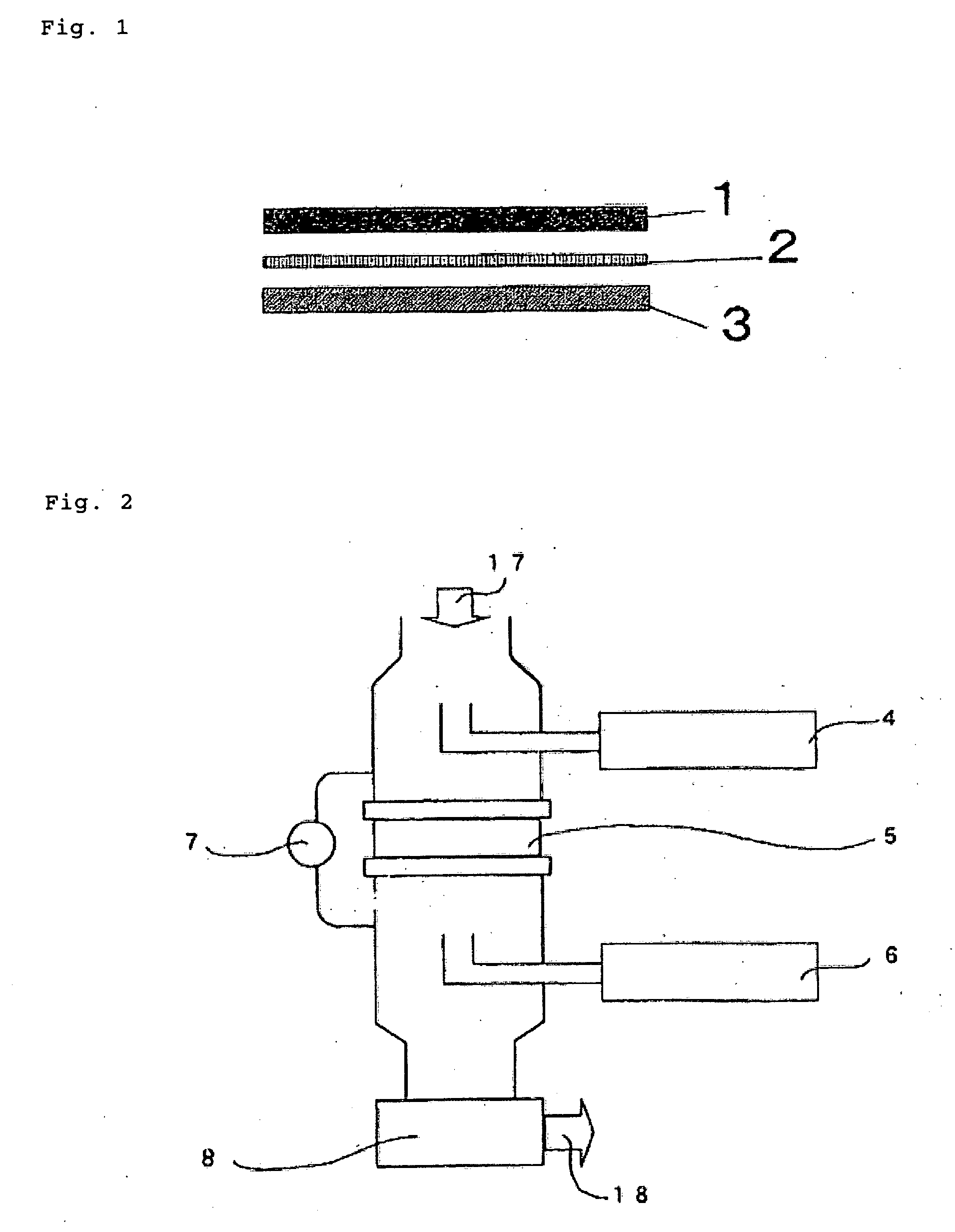Filter medium
a filter cloth and filter medium technology, applied in the field of filter cloth, can solve the problems of physical deterioration, physical deterioration, and physical deterioration of filter cloth while it is used, and achieve the effects of small rise in pressure loss, excellent dust collection efficiency, and high mechanical strength
- Summary
- Abstract
- Description
- Claims
- Application Information
AI Technical Summary
Benefits of technology
Problems solved by technology
Method used
Image
Examples
example 1
[0119] PPS staple fibers with a fineness of 3.0 dtex (fiber diameter 17 μm) and a cut length of 76 mm (“TORCON®” S101-3.0T76 mm, produced by Toray Industries, Inc.) were used to obtain a spun yarn (total fineness 600 dtex) having a single yarn count of 20 s obtained by doubling two yarns. Yarns, each produced as above, were used to form a PPS spun yarn plain weave fabric with a warp density of 26 threads / 2.54 cm and a weft density of 18 threads / 2.54 cm. The woven fabric was used as the scrim. Meanwhile, PPS staple fibers with a fineness of 2.2 dtex (fiber diameter 14.5 μm) and a cut length of 51 mm (“TORCON®” S101-2.2T51 mm, produced by Toray Industries, Inc.) and PPS staple fibers with a fineness of 1.0 dtex (fiber diameter 9.7 μm) and a cut length of 51 mm (“TORCON®” S101-1.0T51 mm, produced by Toray Industries, Inc.) were blended at a ratio by weight of 50:50, and the blended staple fibers were treated using an opener and a carding machine, and temporarily needle-punched at a nee...
example 2
[0120] PPS staple fibers with a fineness of 1.0 dtex (fiber diameter 9.7 μm) and a cut length of 51 mm, PPS staple fibers with a fineness of 2.2 dtex (fiber diameter 14.5 μm) and a cut length of 51 mm, and PPS staple fibers with a fineness of 7.8 dtex (fiber diameter 27.2 μm) and a cut length of 51 mm were blended at 30:30:40, for being used as the fibers constituting the web on the dust side. Furthermore, PPS staple fibers with a fineness of 2.2 dtex and a cut length of 51 mm and PPS staple fibers with a fineness of 7.8 dtex and a cut length of 51 mm were blended at 50:50 for being used as the fibers constituting the web on the clean side. A filter fabric was obtained by the same method as described for Example 1, except that the above webs were used. The performance of the obtained filter fabric is shown in Table 1 and FIGS. 4 and 5.
example 3
[0121] A filter fabric was obtained by the same method as described for Example 1, except that PPS staple fibers with a fineness of 1.0 dtex (fiber diameter 9.7 μm) and a cut length of 51 mm and PPS staple fibers with a fineness of 2.2 dtex (fiber diameter 14.5 μm) and a cut length of 51 mm were blended for being used as the fibers constituting the web on the dust side. The performance of the obtained filter fabric is shown in Table 1 and FIGS. 4 and 5.
PUM
| Property | Measurement | Unit |
|---|---|---|
| diameter | aaaaa | aaaaa |
| diameter | aaaaa | aaaaa |
| diameter | aaaaa | aaaaa |
Abstract
Description
Claims
Application Information
 Login to View More
Login to View More - R&D
- Intellectual Property
- Life Sciences
- Materials
- Tech Scout
- Unparalleled Data Quality
- Higher Quality Content
- 60% Fewer Hallucinations
Browse by: Latest US Patents, China's latest patents, Technical Efficacy Thesaurus, Application Domain, Technology Topic, Popular Technical Reports.
© 2025 PatSnap. All rights reserved.Legal|Privacy policy|Modern Slavery Act Transparency Statement|Sitemap|About US| Contact US: help@patsnap.com



